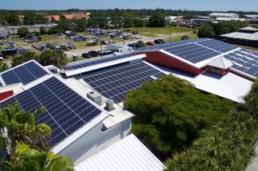Creating Financial Savings for Nonprofits through Energy Improvements
Year Complete: 2021
Grant Amount: $150,000
Local Government: Sarasota City and County
Local Foundation: Gulf Coast Community Foundation, Charles and Margery Barancik Foundation, Community Foundation of Sarasota County
Project Purpose
To empower human services and environmental non-profits to focus limited funds on their program’s mission through energy efficiency and renewable energy roadmaps and facility improvements.
Key Lessons Learned
This project was based on the Southface Grants to Green Project (now known as GoodUse) model. Lessons from the pilot are:
- Nonprofit energy efficiency programs are a clear need across the country. Nonprofits have proven to be an eager and enthusiastic audience that recognize the benefits of this work. This model would work well in most communities, particularly those with well-organized networks, which have been critical to communicating the opportunity and educating nonprofits on energy opportunities.
- Utility demand charges are complicated and dramatically affect an organization’s energy and solar calculations. Also, auditing services can be hard to procure in a consistent way. The audits themselves needed quality control and improvements with significant county and city staff time required. The pilot partners were integral to this process by helping recruit and educate the other nonprofits.
- An iterative project implementation process would be more beneficial for the nonprofits, which have many more upgrades to do on their facilities. They need the opportunity to continue to apply for funds for continuous energy improvement phases.
- Throughout the project implementation process, there was a lot of technical support needed for the nonprofits. It would be better to have year-round in-house support like GoodUse does, rather than the contracted approach, since expertise was needed after the audits were done. This took significant staff and volunteer time to manage.
- Incorporating solar demonstrates that the participating nonprofits can get to net zero energy over time. The nonprofits that are adding solar to their facilities will experience more savings over time and are helping with local City and County renewable energy and climate change goals.
- Another challenge has been limited resources for communications support. In-kind support was received from a local marketing firm, but the program cannot meet its full potential without the ability to tell the stories of the nonprofits. By sharing what the nonprofits did, other organizations, businesses, and their clients can be influenced to take action. In addition, there is a lack of professional images that can help document the project story.
- Lastly, managing and collecting the utility data from each nonprofit was time consuming and complicated. It involved legal requests from the local utility and reminding nonprofits to fill out their ENERGY STAR Portfolio Manager repeatedly.
Leadership by individual foundation staff is invaluable in making connections, drawing attention to a cause, and encouraging nonprofit involvement. Their direct and high-profile involvement influenced everything from the media coverage of events to the number of nonprofits that attended the events and applied to the program. Relationships have been built over many years, and the partnership is strong and longstanding.
The local foundations were also very helpful in identifying nonprofits that would be a good fit for the program. They understand the financial fitness of the nonprofits as well as their community impact and how they function. They also helped motivate nonprofits to participate.
Over the course of the relationship with the foundations, County and City sustainability staff are now invited to an annual meeting with one of the local foundations to present current environmental projects and priorities. These meetings help inform the foundation staff and guide decisions on where funding will go for the year. Discussions are also ongoing as to future funding and evolution of this program.
Additional Information and Resources
Several of the nonprofits who received efficiency upgrades will also participate in a Solar Loan Fund to finance solar photovoltaic systems for their facilities. More information can be found here.

